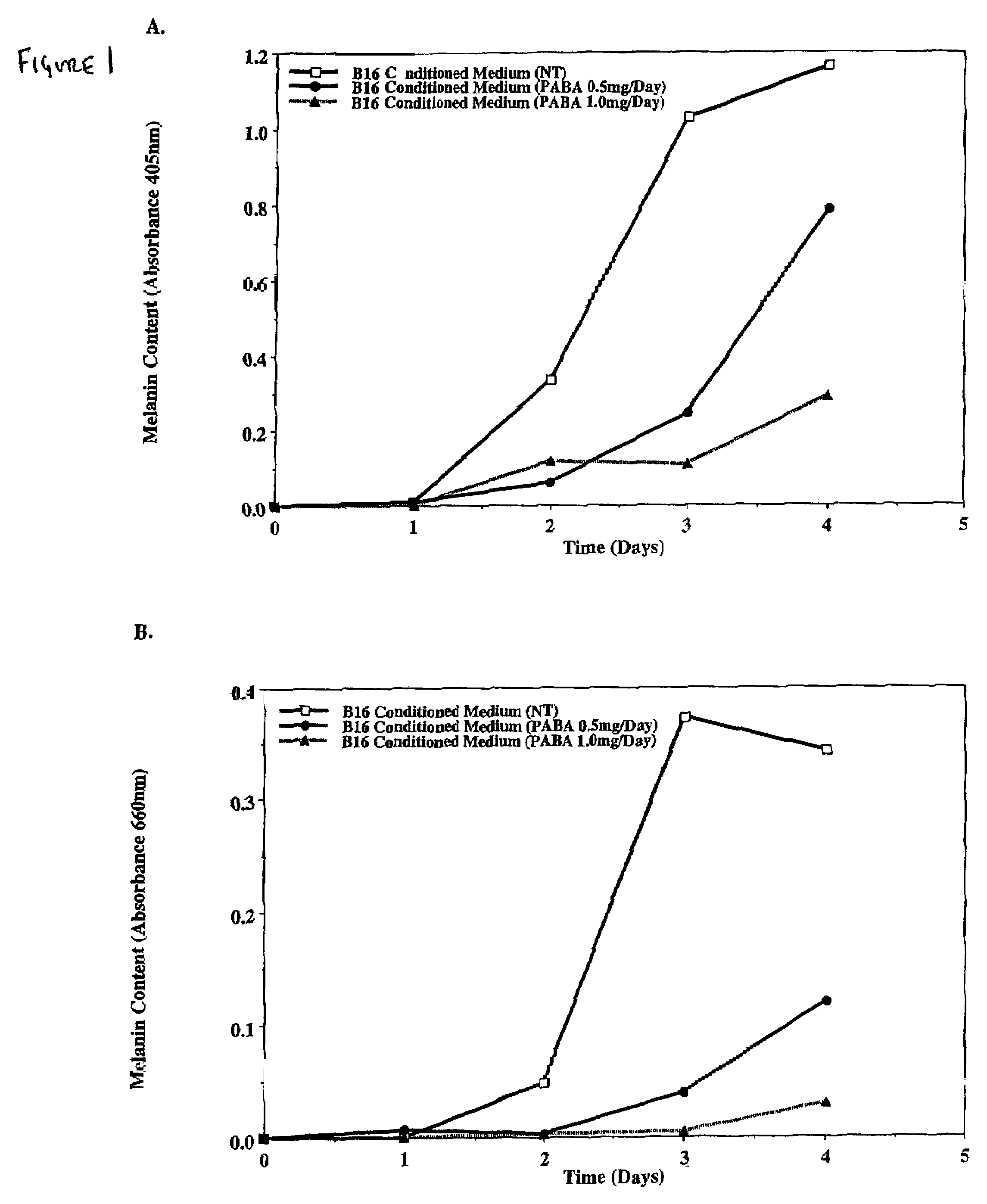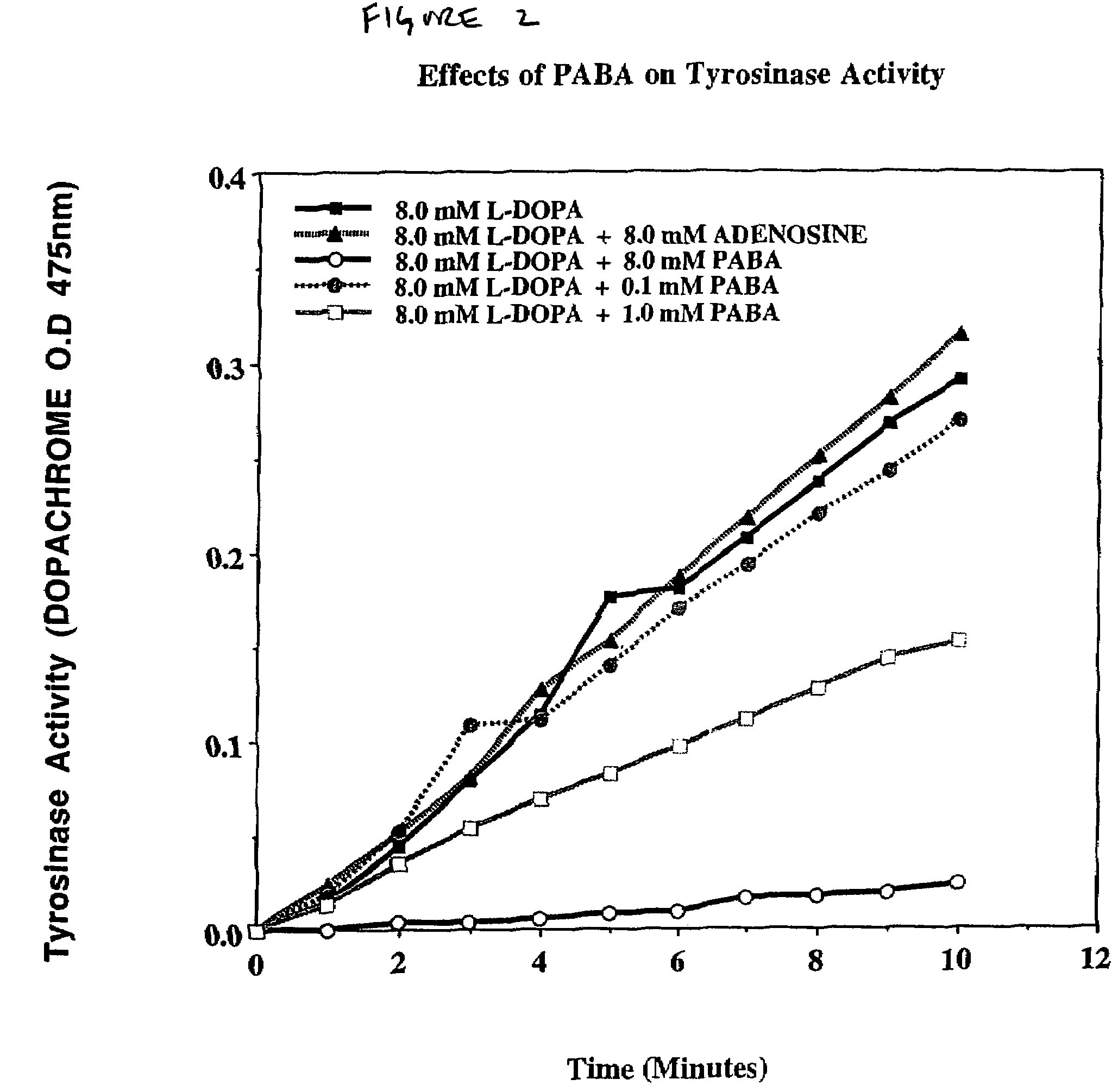Inhibition of melanogenesis and melanoma metastasis with p-aminobenzoic acid (PABA)
a technology of paraaminobenzoic acid and melanogenesis, which is applied in the direction of biocide, drug composition, peptide/protein ingredients, etc., can solve the problems of increased risk of recurrence and recurrence, significant drop in survival chance, poor treatment prospects of advanced melanoma, etc., and achieves the effect of enhancing, rather than inhibiting, the growth of carcinoma tumors
- Summary
- Abstract
- Description
- Claims
- Application Information
AI Technical Summary
Benefits of technology
Problems solved by technology
Method used
Image
Examples
example 1
PABA Suppresses Secretion of Melanin in B16 Melanoma Cells Cultured in Vitro
[0080]Growth of melanotic B16 melanoma cells (Engbring J A et al. (2002) Cancer Res 62:3549-3554) in DMEM medium (available from, e.g. Life Technologies, Inc., Rockville Md.) resulted in a change of the color of the medium from red to brown due to the accumulation of secreted melanin. Growth of melanotic B16 melanoma cells in RPMI medium (available from, e.g. Life Technologies, Inc., Rockville Md.) did not result in a color change. The RPMI medium remained red due to the inhibition of melanin secretion. One of the major components in RPMI that is absent in DMEM is PABA. To assess the effect of PABA on melanin secretion from B16 cells, PABA was added to DMEM culture medium to achieve the same concentration as that found in the RPMI medium: 0.1 mg of PABA per milliliter of medium. Cells were grown in PABA-supplemented DMEM medium for seven days. The PABA-supplemented medium remained red, while the unsupplement...
example 2
Time and Concentration Dependent Inhibition of Melanin Synthesis and Secretion
[0081]To further analyze the effects of PABA on B16 melanoma cell melanin secretion, PABA was added at concentrations of 0.5 mg / day and 1.0 mg / day to B16 melanoma cells cultured in DMEM. Samples of the culture medium were then analyzed for melanin content by measuring absorbance at wavelengths of 405 nm and 660 nm. (Kowalczuk C et al. (2001) Inter J Rad Biol 77:883-890.) The addition of PABA caused a time dependent and concentration dependent inhibition of melanin secretion (FIGS. 1A and 1B).
example 3
PABA Suppresses Intracellular Synthesis of Melanin within B16 Melanoma Cells
[0082]To determine whether PABA inhibits the intracellular synthesis of melanin in B16 cells, cells were grown in DMEM in the presence or absence of 0.1 mg / ml PABA. Following three weeks of culture, cells were collected by centrifugation. Cell pellets from cells cultured in the absence of PABA appeared black, as normal, indicating the presence of melanin. B16 melanoma cells cultured in the presence of PABA appeared much lighter in color, indicating a reduction in melanin accumulation. These results indicate that PABA inhibits melanin synthesis and / or accumulation within melanoma cells.
PUM
| Property | Measurement | Unit |
|---|---|---|
| wavelength | aaaaa | aaaaa |
| wavelength | aaaaa | aaaaa |
| molecular weights | aaaaa | aaaaa |
Abstract
Description
Claims
Application Information
 Login to View More
Login to View More - R&D
- Intellectual Property
- Life Sciences
- Materials
- Tech Scout
- Unparalleled Data Quality
- Higher Quality Content
- 60% Fewer Hallucinations
Browse by: Latest US Patents, China's latest patents, Technical Efficacy Thesaurus, Application Domain, Technology Topic, Popular Technical Reports.
© 2025 PatSnap. All rights reserved.Legal|Privacy policy|Modern Slavery Act Transparency Statement|Sitemap|About US| Contact US: help@patsnap.com



